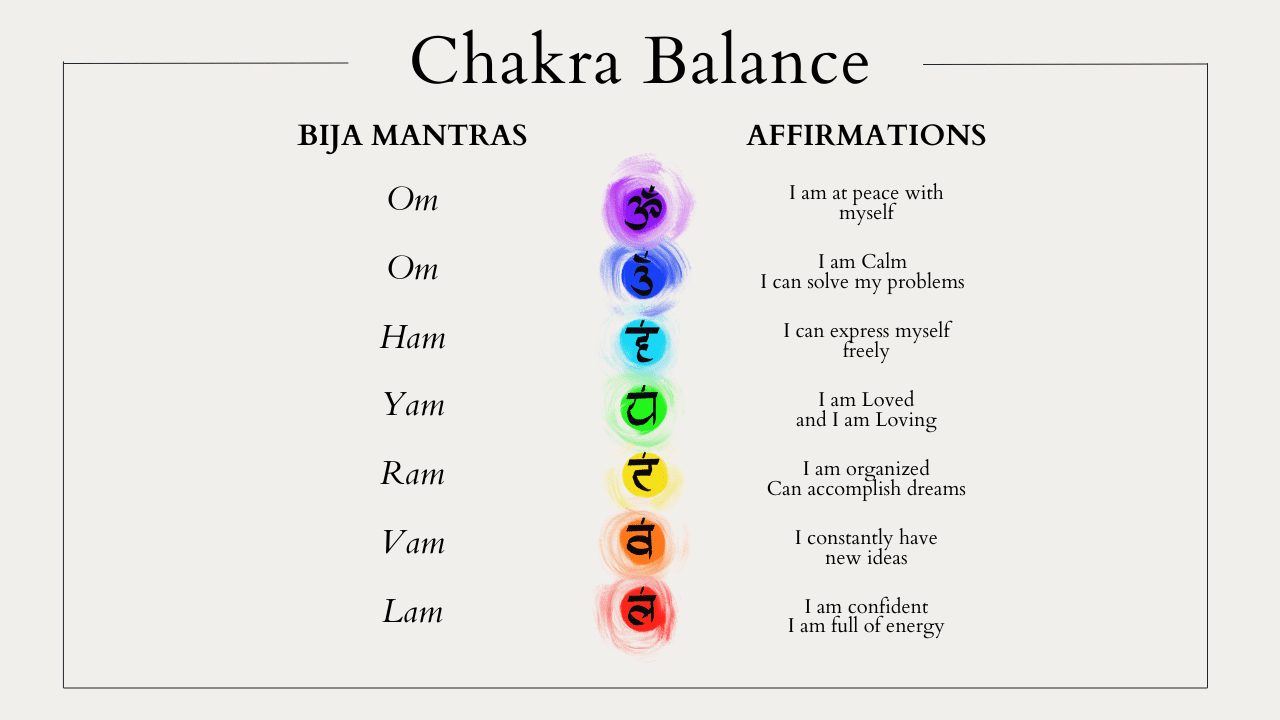Balancing Chakras: Techniques & Practices
Introduction
Have you ever experienced a moment of intense emotion and noticed a sensation in a specific part of your body? Perhaps it was a warmth in your belly after a delicious meal, furrowing of your eyebrows in anger, or a lump in your throat during moments of tears. These physical manifestations of our emotions are not mere coincidences! Ancient yogic philosophy explains these connections through the concept of chakras, which are energy centers in our body. This article will explore what chakras are, why they’re important, and how to achieve balance in your chakras.

Understanding the Seven Main Chakras
1. Root Chakra (Muladhara)
Location: Base of the spine (tailbone area)
Color: Red
Element: Earth
Symbolism: Stability, security, foundation, grounding
Physical Aspects: Spine, legs, feet, bones, immune system
Emotional Aspects: Groundedness, survival instincts, safety, sense of belonging
Spiritual Aspects: Connection to the physical world, feeling supported by life
Signs of Imbalance: Anxiety, fear, fatigue, lethargy, financial instability, feeling disconnected from self or environment.
2. Sacral Chakra (Swadhisthana)
Location: Lower abdomen, below the navel
Color: Orange
Element: Water
Symbolism: Creativity, pleasure, emotional well-being
Physical Aspects: Reproductive organs, lower back, hips
Emotional Aspects: Passion, desire, intimacy, joy, emotional expression
Spiritual Aspects: Flow, emotional intelligence, Personal creativity, life force energy
Signs of Imbalance: creative blocks, emotional numbness, fear of intimacy
3. Solar Plexus Chakra (Manipura)
Location: Upper abdomen, near the stomach
Color: Yellow
Element: Fire
Symbolism: Personal power, self-esteem, confidence
Physical Aspects: Digestive system, stomach, metabolism, adrenal glands
Emotional Aspects: Willpower, self-worth, motivation
Spiritual Aspects: Transformation, manifestation, inner strength, self-discipline
Signs of Imbalance: Low self-esteem, digestive issues, lack of motivation, feeling powerless, difficulty making decisions
4. Heart Chakra (Anahata)
Location: Center of the chest, near the heart
Color: Green (sometimes depicted as pink)
Element: Air
Symbolism: Love, compassion, connection, forgiveness
Physical Aspects: Heart, lungs, circulatory system
Emotional Aspects: Empathy, forgiveness, compassion
Spiritual Aspects: Unconditional love, self-love, connection to others
Signs of Imbalance: Difficulty in giving or receiving love, grief, heartache, isolation, resentment, jealousy
5. Throat Chakra (Vishuddha)
Location: Throat
Color: Blue
Element: Ether
Symbolism: Communication, expression, authenticity
Physical Aspects: Throat, neck, thyroid gland
Emotional Aspects: self-expression, speaking one’s truth, listening skills
Spiritual Aspects: Speaking your truth, listening to your inner voice
Signs of Imbalance: Fear of speaking up, difficulty expressing oneself, throat issues, communication breakdowns
6. Third Eye Chakra (Ajna)
Location: Between the eyebrows, forehead area
Color: Indigo or deep blue
Element: Light
Symbolism: Intuition, insight, inner wisdom, imagination
Physical Aspects: Brain, eyes, pituitary gland
Emotional Aspects: Clarity of thought, imagination, intuition
Spiritual Aspects: Perception beyond the physical, connection to higher consciousness
Signs of Imbalance: Lack of clarity, confusion, lack of focus, headaches, difficulty accessing intuition
7. Crown Chakra (Sahasrara)
Location: Top of the head
Color: Violet or white
Element: Thought, consciousness
Symbolism: Spiritual connection, enlightenment, divine presence
Physical Aspects: Brain, nervous system, pineal gland
Emotional Aspects: Bliss, spiritual awakening, unity consciousness
Spiritual Aspects: Oneness, enlightment, connection to the divine
Signs of Imbalance: Disconnect from self and spirituality, feeling lost, closed-mindedness, depression
Techniques for Opening Chakras Through Meditation
A. Breathwork for Chakra Activation
1. Deep Breathing Exercises
Deep breathing exercises, often referred to as diaphragmatic or abdominal breathing, encourage the intake of more oxygen into the body, promoting relaxation and reducing stress. They serve as a foundational practice for chakra activation, allowing us to cultivate awareness of our breath and channel prana, or life force energy, throughout the body. By consciously inhaling deeply into the belly and exhaling fully, we stimulate the flow of energy, releasing blockages and restoring balance to the chakras.
How to do it – Visualize your breath flowing down to the base of your spine and filling your entire body as you inhale. Exhale slowly, releasing any tension or blockages.
2. Alternate Nostril Breathing (Nadi Shodhana)
Nadi Shodhana, also known as alternate nostril breathing, is a powerful pranayama technique that balances the flow of energy between the left and right sides of the body, as well as the masculine and feminine energies within us. When applied in chakra meditation, Nadi Shodhana balances the flow of energy through your nostrils, which are believed to be connected to different energy channels (nadis) in your body.
How to do it – Close your right nostril and inhale through your left. Hold your breath briefly, then close your left nostril and exhale through your right. Repeat, alternating sides.
B. Mantra Meditation
1. Chanting Mantras for Each Chakra
Chanting specific mantras associated with each chakra can aid in aligning and activating the energy centers. Mantra meditation involves the repetition of sacred sounds or phrases, known as mantras, to evoke specific qualities and vibrations within the chakras. These mantras are believed to vibrate at the frequency of their corresponding chakra. Regularly chanting these mantras during meditation can help activate and cleanse the chakras. Each chakra has its own unique seed mantra, a bija mantra.
2. Affirmations
Repeating affirmations or positive statements related to each chakra during meditation can help reinforce a balanced and harmonious energy flow. By focusing on affirmations such as “I am grounded and secure” for the root chakra or “I am open to love and compassion” for the heart chakra, practitioners can consciously realign and activate the chakras.

C. Yoga Poses (Asanas) for Chakra Balancing
1. Asanas Targeting Specific Chakras
Certain yoga postures are specifically tailored to target and stimulate individual chakras. For example, poses like Malasana (garland pose) and Virabhadrasana (warrior pose) can help in grounding and energizing the root chakra, while Camel Pose (Ustrasana) can benefit the heart chakra.
2. Flowing Sequences for Overall Alignment
Flowing sequences, such as Sun Salutations (Surya Namaskar) or Vinyasa Flow, offer a dynamic and holistic approach to chakra balancing, movement, breath, and mindfulness. By moving through a series of synchronized poses with awareness and intention, we awaken the entire chakra system, fostering a sense of wholeness and alignment.
Maintaining Chakra Balance
Maintaining Chakra Balance is a continuous process that leads to holistic well-being on physical, emotional, and spiritual levels. This section explores its key aspects:
Regular Practice and Consistency
Engaging in short, daily meditations or mindful moments can significantly impact your chakras. Consistency in engaging with chakra work can help stabilize and optimize the flow of energy.
By incorporating chakra work into your daily routine, you can embed the practice into your lifestyle, ensuring that nurturing your energetic well-being becomes an integral part of your everyday life.
Self-awareness and Reflection
Self-awareness is the cornerstone of chakra balance, allowing us to observe our thoughts, emotions, and energy fluctuations with compassion and curiosity. Developing a deeper understanding of your energy is crucial for maintaining balanced chakras. For example, to pay attention to how you feel throughout the day. Are you feeling sluggish (root chakra imbalance) or overly critical (throat chakra imbalance)? Identifying emotional or physical cues can guide you toward the chakra that needs attention.
Once you suspect an imbalance, explore techniques like meditation, breathwork, or yoga poses that target that specific chakra. Additionally, consider journaling about your experiences to track your progress.
Holistic Healing Practices
Several complementary practices can support the chakra balancing journey. Explore alternative healing practices such as sound therapy, and acupuncture offer powerful tools for clearing blockages, replenishing energy, and promoting deep relaxation. These can offer a different perspective on chakra balancing.
Conclusion
The journey of chakra awakening is an ongoing process. We are the master of our own energy! With each mindful breath, each intentional movement, and each exploration of your inner landscape, you move closer to unlocking the transformative power of chakra work and embracing a life filled with balance and harmony.
While chakras play a crucial role, they are just a small part of yoga’s rich philosophy. If you’re curious to learn more, check out our post on 8 limbs of yoga!
